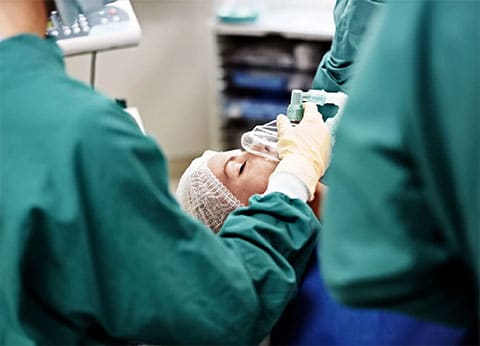New York Center for Facial Plastic Surgery
Schedule a consultation
Schedule today

Information about twilight sedation in New York, NY with Top Facial Cosmetic Surgeon, Dr. Andrew Jacono.
The average cosmetic patient focuses on the techniques that help them look their best. Whether this be in the form of injections or surgery, consumers are fascinated by the procedures that turn back time. In the case of a facelift, for example, clients often ask their doctor about incisions, tissue manipulation, and even the placement of sutures. More information helps patients feel at ease as they enter the operating room and minimizes miscommunications.
What most patients don’t consider is the kind of anesthesia used during surgery. Anesthesia makes every procedure simple and painless. It also means the difference between an easy recovery and a difficult one.

“From its inception, anesthesia has been a revolutionary addition to surgery,” says Dr. Jacono. “It maximizes comfort and eliminates most complications. Modern surgery would not be where it is without effective anesthesia.”
For many aesthetic surgical procedures, doctors use what is known as twilight anesthesia, or conscious sedation. Normally, propofol is used to induce sedation, though some doctors use drugs like fentanyl ad ketamine. Twilight anesthesia renders the patient in a state of complete calm, though they are never quite unconscious. Instead, they are awake but unable to feel pain in target areas.
Some may wonder why anyone would choose twilight sedation over general anesthesia, which renders patients completely unconscious. There are a few reasons for this. After surgery, general anesthesia can cause nausea, discomfort, and even increased bruising and swelling. Patients may also feel extremely groggy after their procedure.
Twilight anesthesia, on the other hand, causes none of these complications. In fact, most patients feel as though they have just emerged from a deep, restful sleep after surgery. There is no residual nausea or discomfort, and most clients do not feel unwell once their procedure is done.
“With twilight anesthesia, the body is awake, but the mind isn’t,” says Dr. Jacono. “You breathe, you swallow, you cough, and you even sneeze, but you’re unaware of any of it—you’re not able to feel discomfort or pain. In some cases, patients even fall asleep once the medicine has been administered.”
To further reduce pain, surgeons will use local anesthesia. This is an injectable solution that numbs areas. It also minimizes bleeding during surgery, as it temporarily constricts blood vessels. Combining twilight sedation with local anesthesia is incredibly common and very safe.
“I routinely use twilight in tandem with local,” says Dr. Jacono. “They go hand-in-hand and complement each other extremely well. Together, they allow for a seamless surgical experience.”
In addition to a more comfortable surgical experience, twilight anesthesia has a slew of other benefits. Sedated patients tend to wake up quicker and recover faster than those who have had general anesthesia. They also experience far fewer side effects of nausea and dizziness. Patients may wake up drowsy but will only feel this way for about 30 minutes.
Additionally, and most reassuringly, patients will not remember the procedure. Some clients may recall dreams that they had during twilight sedation, but virtually none will note pain or anxiety.
“The fact of the matter is that twilight anesthesia makes the surgical experience simple and comfortable,” says Dr. Jacono. “They don’t have to worry about discomfort before, during, or after their procedure. They can rest assured that they will be completely safe as the operation progresses. It is also reassuring for them to know that side effects are minimal. Nobody wants to feel uncomfortable after surgery, no matter how major or minor it was.”
Of course, those who would prefer to undergo surgery with general anesthesia are permitted to do so. This is not to say, however, that physicians don’t have their preferences. Dr. Jacono, for example, swears by twilight anesthesia.
Dr. Andrew Jacono, M.D., FACS, is a world-renowned specialist in minimally invasive facial rejuvenation. He is an assistant clinical professor at the New York Eye and Ear Infirmary and at the Albert Einstein College of Medicine. He is also the head of facial plastic surgery at North Shore University Hospital and a fellowship director for the American Academy of Facial Plastic and Reconstructive Surgery.
Dr. Jacono has published studies in many major medical journals, including the Aesthetic Surgery Journal and the Archives of Facial Plastic Surgery. Several news outlets have covered him and his work, including Good Morning America, Anderson, and CNN, as well as USA Today, Parade, and Newsweek. Dr. Jacono’s reality television series, Facing Trauma, appeared on the Oprah Winfrey Network.
Jacono is a senior advisor to FACE TO FACE, an organization that offers pro bono surgery to domestic violence victims. He is also a volunteer surgeon for the nonprofit organization Healing the Children.

Accessibility: If you are vision-impaired or have some other impairment covered by the Americans with Disabilities Act or a similar law, and you wish to discuss potential accommodations related to using this website, please contact our Accessibility Manager at (212) 570-2500 .